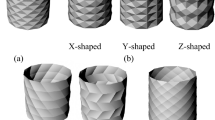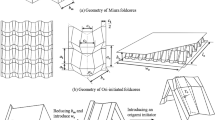Abstract
Origami techniques derived from antique paper folding arts have been applied to solve engineering problems such as weight/space-saving structures and their rapid deployment for foldability. Recently, origami techniques’ potential in mechanical reinforcement for structural designs has also been discussed. For example, the mechanical performance of origami tubular structures can be significantly improved compared with the circular and hexagonal tubes under lateral loading. In this paper, an origami-inspired tubular structure was applied as the infill pattern for additive manufacturing, and energy absorption performance under dynamic and static loadings was investigated. Fused filament fabrication was selected as the testbed for the origami-inspired infill pattern investigation. The samples with the origami infill pattern presented higher dynamic and quasi-static energy absorption performance than samples with grid or honeycomb infill patterns. The proposed structural reinforcement method can be expanded to crash-worthy structures, thin-wall structures, functional structures, and the design of lightweight, high-strength parts.






Similar content being viewed by others
Availability of data and material
The authors confirm that the data supporting the findings of this study are available within the article.
Code availability
Not applicable.
References
Campbell I, Bourell D, Gibson I (2012) Additive manufacturing: rapid prototyping comes of age. Rapid Prototyp J 18:255–258. https://doi.org/10.1108/13552541211231563
Ngo TD, Kashani A, Imbalzano G et al (2018) Additive manufacturing (3D printing): a review of materials, methods, applications and challenges. Compos Part B Eng 143:172–196. https://doi.org/10.1016/j.compositesb.2018.02.012
ISO/ASTM 52900:2021 (2021) Additive manufacturing - General principles - Fundamentals and vocabulary
Aguilar-Duque JI, Hernández-Arellano JL, Avelar-Sosa L et al (2019) Additive manufacturing: fused deposition modeling advances. In: García Alcaraz JL, Rivera Cadavid L, González-Ramírez RG et al (eds) Best practices in manufacturing processes: experiences from Latin America. Springer International Publishing, Cham, pp 347–366
Ravindrababu S, Govdeli Y, Wong ZW, Kayacan E (2018) Evaluation of the influence of build and print orientations of unmanned aerial vehicle parts fabricated using fused deposition modeling process. J Manuf Process 34:659–666. https://doi.org/10.1016/j.jmapro.2018.07.007
Yadav DK, Srivastava R, Dev S (2020) Design & fabrication of ABS part by FDM for automobile application. Mater Today Proc 26:2089–2093. https://doi.org/10.1016/j.matpr.2020.02.451
Zaneldin E, Ahmed W, Mansour A, Hassan AE (2021) Dimensional stability of 3D printed objects made from plastic waste using FDM: potential construction applications. Build 11
Coronel JL, Masum Billah KM, Acosta Carrasco CF et al (2020) Hybrid manufacturing with FDM technology for enabling power electronics component fabrication. Solid Free Fabr 2018 Proc 29th Annu Int Solid Free Fabr Symp - An Addit Manuf Conf SFF 2018 357–364
Sun Q, Rizvi GM, Bellehumeur CT, Gu P (2008) Effect of processing conditions on the bonding quality of FDM polymer filaments. Rapid Prototyp J 14:72–80. https://doi.org/10.1108/13552540810862028
Abbott AC, Tandon GP, Bradford RL et al (2018) Process-structure-property effects on ABS bond strength in fused filament fabrication. Addit Manuf 19:29–38. https://doi.org/10.1016/j.addma.2017.11.002
Rajpurohit SR, Dave HK (2018) Effect of process parameters on tensile strength of FDM printed PLA part. Rapid Prototyp J 24:1317–1324. https://doi.org/10.1108/RPJ-06-2017-0134
Stavropoulos P, Foteinopoulos P, Papapacharalampopoulos A (2021) On the impact of additive manufacturing processes complexity on modelling. Appl Sci 11:7743. https://doi.org/10.3390/app11167743
Stavropoulos P, Papacharalampopoulos A, Michail CK, Chryssolouris G (2021) Robust additive manufacturing performance through a control oriented digital twin. Metals (Basel) 11:708. https://doi.org/10.3390/met11050708
Makris S, Aivaliotis P (2021) Framework for accurate simulation and model-based control of hybrid manufacturing processes. Procedia CIRP 97:470–475. https://doi.org/10.1016/j.procir.2020.07.007
Fernandez-Vicente M, Calle W, Ferrandiz S, Conejero A (2016) Effect of infill parameters on tensile mechanical behavior in desktop 3D printing. 3D Print Addit Manuf 3:183–192. https://doi.org/10.1089/3dp.2015.0036
Alafaghani A, Qattawi A (2018) Investigating the effect of fused deposition modeling processing parameters using Taguchi design of experiment method. J Manuf Process 36:164–174. https://doi.org/10.1016/j.jmapro.2018.09.025
Sunny SF, Rostami S, Malik AS (2018) Effects of fluid cavity modeling when predicting compressive strength of FDM printed nylon with varying infill pattern and density. In: Volume 1: Additive Manufacturing; Bio and Sustainable Manufacturing. Am Soc Mech Eng
Mishra PK, Senthil P, Adarsh S, Anoop MS (2021) An investigation to study the combined effect of different infill pattern and infill density on the impact strength of 3D printed polylactic acid parts. Compos Commun 24:100605. https://doi.org/10.1016/j.coco.2020.100605
Shen W, Cao Y, Jiang X et al (2021) Experimental and numerical investigation on radial stiffness of origami-inspired tubular structures. J Appl Mech. 89 https://doi.org/10.1115/1.4052799
Hyde RA, Dixit SN, Weisberg AH, Rushford MC (2002) Eyeglass: a very large aperture diffractive space telescope. Highly Innov Sp Telesc Concepts 4849:28. https://doi.org/10.1117/12.460420
Song J, Chen Y, Lu G (2012) Axial crushing of thin-walled structures with origami patterns. Thin-Walled Struct 54:65–71. https://doi.org/10.1016/j.tws.2012.02.007
Lee TU, Yang X, Ma J et al (2019) Elastic buckling shape control of thin-walled cylinder using pre-embedded curved-crease origami patterns. Int J Mech Sci 151:322–330. https://doi.org/10.1016/j.ijmecsci.2018.11.005
Ma J, Song J, Chen Y (2018) An origami-inspired structure with graded stiffness. Int J Mech Sci 136:134–142. https://doi.org/10.1016/j.ijmecsci.2017.12.026
Leevers PS (1999) Impact strength BT - mechanical properties and testing of polymers: an A–Z reference. In: Swallowe GM (ed). Springer Netherlands, Dordrecht, pp 127–129
Acknowledgements
The authors would like to thank Aaron Jordan and Mattew Janowicz for providing the instruments training and lab support for this study.
Funding
This paper is based on the work supported by the Iowa Energy Center (IEC) Award Number 20-IEC-015 and the Exploratory Research Project grant from the Department of Industrial and Manufacturing Systems Engineering (IMSE_ERP) at Iowa State University.
Author information
Authors and Affiliations
Contributions
Weijun Shen: conceptualisation; methodology; validation; formal analysis; investigation; data curation; writing—original draft preparation; writing–review and editing. Xuepeng Jiang: methodology, validation, formal analysis, investigation, data curation, writing—original draft preparation. Zhan Zhang: conceptualisation; methodology investigation; writing—review and editing; project administration; funding acquisition. Gül E. Okudan-Kremer: conceptualisation; methodology; formal analysis; investigation; writing—review and editing; supervision; project administration; funding acquisition. Hantang Qin: generation of project ideas; conceptualisation; methodology; validation; investigation; writing—review and editing; project administration; funding acquisition.
Corresponding author
Ethics declarations
Ethics approval
The article involves no studies on human or animal subjects.
Consent to participate
All authors were fully involved in the study and preparation of the manuscript, and each of the authors has read and concurred with the content in the final manuscript.
Consent for publication
All authors consent to publish the content in the final manuscript.
Competing interests
The authors declare no competing interests.
Additional information
Publisher's Note
Springer Nature remains neutral with regard to jurisdictional claims in published maps and institutional affiliations.
Rights and permissions
Springer Nature or its licensor holds exclusive rights to this article under a publishing agreement with the author(s) or other rightsholder(s); author self-archiving of the accepted manuscript version of this article is solely governed by the terms of such publishing agreement and applicable law.
About this article
Cite this article
Shen, W., Jiang, X., Zhang, Z. et al. An origami-inspired infill pattern for additive manufacturing to reinforce the energy absorption performance. Int J Adv Manuf Technol 122, 4267–4274 (2022). https://doi.org/10.1007/s00170-022-09883-w
Received:
Accepted:
Published:
Issue Date:
DOI: https://doi.org/10.1007/s00170-022-09883-w




